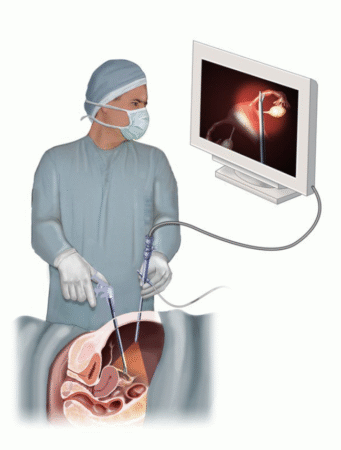Diagnostic and Therapeutic Laparoscopy
What is Laparoscopy?
Laparoscopy is a minimally invasive surgical procedure in which a special instrument called a laparoscope is inserted into the abdominal and pelvic cavity through one or more small incisions.
The laparoscope is connected to a camera, allowing the surgeon to clearly visualize the uterus, ovaries, and fallopian tubes. If any abnormalities are detected, many of them can be corrected during the same procedure.
Laparoscopy serves both diagnostic and therapeutic purposes and, in gynecology, has largely replaced traditional open surgery (laparotomy) for many conditions.
Advantages of Laparoscopy Compared to Laparotomy
- Shorter operation time
- Smaller scars
- Less postoperative pain
- Earlier discharge from hospital
- Faster recovery
- Lower risk of adhesions
- Reduced infection rates
- Lower costs
Indications for Laparoscopy
- Investigating causes of chronic abdominal or pelvic pain
- Evaluating infertility
- Biopsy of pelvic masses
- Diagnosis and treatment of endometriosis and endometriomas
- Assessment of tubal blockage
- Removal of certain uterine fibroids
- Surgical management of ectopic pregnancy
- Hysterectomy (removal of the uterus)
- Removal of ovaries or ovarian cysts
- Tubal ligation (permanent contraception)
- Treatment of urinary incontinence and pelvic organ prolapse
- Removal of some cancerous tumors
- Assisted reproductive techniques such as ZIFT and GIFT
- Other gynecological conditions
In some cases, laparoscopy may need to be converted to laparotomy during surgery if wider access is required.
Timing of Laparoscopy
- Ideally performed 2–5 days after menstruation to ensure the patient is not pregnant.
- For women of reproductive age, a pregnancy test is required before surgery if not scheduled right after menstruation.
Preoperative Preparation
- Showering and shaving the genital and abdominal area
- Discontinuing Aspirin and Warfarin three days before surgery and heparin one day before (if applicable)
- Fasting for at least 8 hours prior to surgery
- Removing all jewelry, watches, hair accessories, and makeup (including nail polish) before entering the operating room
- Removing glasses, dentures, hearing aids, lenses, or nail prostheses before surgery
- Emptying the bladder immediately before entering the operating room
- Wearing flat shoes and loose clothing on the day of surgery (to reduce discomfort after surgery)
How Laparoscopy is Performed
- The patient is positioned in the lithotomy position (legs supported in stirrups) to allow better access to the pelvic organs.
- The abdomen, external genitalia, and vagina are disinfected.
- General anesthesia is administered for muscle relaxation and pain prevention.
- A small incision is made near the navel to insert the laparoscope, and one or more additional small incisions are made for surgical instruments.
- Carbon dioxide gas is introduced into the abdominal cavity to expand it, separating the abdominal wall from internal organs for better visibility.
- The laparoscope transmits images to a monitor, enabling the surgical team to view internal structures.
- Additional instruments may be inserted through the vagina and cervix to help position pelvic organs.
- Laser or electrocautery may be used, and sometimes a dye test is performed to check the patency of fallopian tubes.
- At the end of the procedure, instruments are removed, the gas is released, and the incisions are sutured.
Hospital Stay and Discharge
- After surgery, the patient is monitored in the recovery room.
- In most cases, discharge is possible the same day, unless the surgery was extensive, in which case discharge may be postponed until the next day.
Postoperative Care
- Pain relief with analgesics (e.g., ibuprofen) every 8 hours as needed
- Taking prescribed antibiotics as directed until completion
- Gradual resumption of daily activities within 2–7 days
- Light household activities and climbing stairs are permitted
- Driving is allowed 3 days after surgery
- Showering is safe the next day (incisions may get wet; keep them clean and dry afterward)
- Sexual activity may resume 5 days after surgery
- Exercise can usually be restarted 5–10 days after surgery
- Swimming is permitted after 7 days
- Avoid lifting heavy objects for 2 weeks
- Follow-up appointment with pathology report in 7–10 days for suture removal and evaluation
Common Postoperative Symptoms
- Nausea due to anesthesia (usually relieved with anti-nausea medication and light diet)
- Abdominal bloating or pain, managed with painkillers
- Fatigue and body aches for several days
- Sore throat from intubation, improved with warm saltwater gargles
- Shoulder or back pain due to residual gas, usually resolving within hours to days (walking and warm compresses help)
- Mild bruising near the incision site
- Urgency in urination due to gas pressure on the bladder
- Slightly discolored urine from dye used in tubal patency testing
- Bloody vaginal discharge for 1–2 days
When to Contact Your Doctor Immediately
- Fainting
- Inability to urinate
- Fever
- Severe pain not relieved by medication
- Persistent nausea or vomiting beyond 24 hours
- Continuous cough or difficulty breathing
- Redness, swelling, discharge, or bleeding from the incision site
- Heavy vaginal bleeding or passage of clots after the first day
Menstruation After Laparoscopy
- The first period usually occurs about one month after surgery
- Some women may experience a delay of 4–6 weeks
- The first period may be heavier and more uncomfortable than usual
Possible Risks and Complications
Although laparoscopy is generally safe, rare complications may include:
- Injury to adjacent organs
- Bladder or bowel perforation (very rare if bladder and bowels are emptied before surgery)
- Bleeding
- Infection
- Anesthesia-related complications
- Diaphragm irritation, which may cause temporary breathing discomfort during prolonged surgeries

